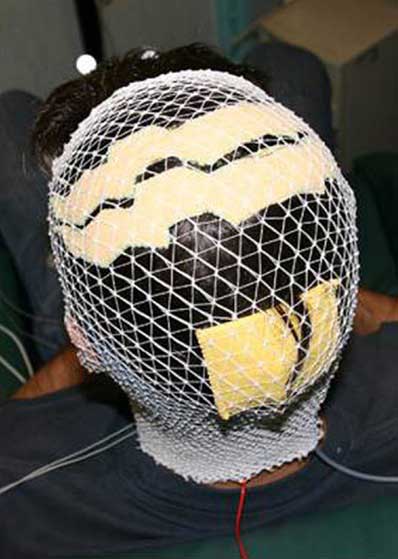Regional personalized electrodes to select transcranial current stimulation target (pdf)
…with the present work we developed a procedure to properly shape the stimulating
electrode.

(The familiar looking square electrodes were the reference electrodes.)
Tags: electrodes, tACS
The Sertraline vs Electrical Current Therapy for Treating Depression Clinical StudyResults From a Factorial, Randomized, Controlled Trial (pdf)
At the main end point, there was a significant difference in Montgomery-Asberg Depression Rating Scale scores when comparing the combined treatment group (sertraline/active tDCS) vs sertraline only, tDCS only, and placebo/sham tDCS… There were 7 episodes of treatment-emergent mania or hypomania, 5 occurring in the combined treatment group.
Tags: depression
Noninvasive transcranial direct current stimulation over the left prefrontal cortex facilitates cognitive flexibility in tool use (pdf)
The results support the hypothesis that certain tasks may benefit from a state of diminished cognitive control.
And a related news story discussing the same paper.
Brain hacking: Electrifying your creative side
Each person was shown pictures of everyday objects and asked to come up with a new uses for them.
The group which received the TDCS muting the left prefrontal cortex was better in coming up with unusual uses than the others — and did it faster.
Tags: creativity, Sharon Thompson-Schill, cathodal stimulation,
Orchestrating neuronal networks: sustained after-effects of transcranial alternating current stimulation depend upon brain states (pdf)
Long lasting after-effects foster the role of tACS as a tool for non-invasive brain stimulation and demonstrate the potential for therapeutic application to reestablish the balance of altered brain oscillations.
Tags: tACS
Different Current Intensities of Anodal Transcranial Direct Current Stimulation Do Not Differentially Modulate Motor Cortex Plasticity (pdf)
targeting M1 …10 minutes of anodal tDCS at 0.8, 1.0, and 1.2 mA
These results suggest that the aftereffect of anodal tDCS on facilitating cortical excitability is due to the modulation of synaptic mechanisms associated with long-term potentiation and is not influenced by different tDCS intensities.
Tags: M1, dosage
Transcranial direct-current stimulation increases extracellular dopamine levels in the rat striatum (pdf)
Following the application of cathodal, but not anodal, tDCS for 10 min, extracellular dopamine levels increased for more than 400 min in the striatum. There were no significant changes in extracellular serotonin levels.
Tags: dopamine
Spark of Genius: A new technology promises to supercharge your brain with electricity. Is it too good to be true?
Surprisingly good pop-sci overview of where we’re at with tDCS. Chock full of relevant links.
Using computational models in tDCS research and clinical trials (pdf)
Hypothesis: Appropriately applied computational models are pivotal for rational tDCS dose selection.
Tags: Comptational modeling, Marom Bikson,
Boosting brain functions: Improving executive functions with behavioral training, neurostimulation, and neurofeedback (pdf)
This review provides a synopsis of two lines of research, investigating the enhancement of capabilities in executive functioning: a) computerized behavioral trainings, and b) approaches for direct neuromodulation (neurofeedback and transcranial electrostimulation).
Tags: cognitive enhancement
Focal Modulation of the Primary Motor Cortex in Fibromyalgia Using 4×1-Ring High-Definition Transcranial Direct Current Stimulation (HD-tDCS): Immediate and Delayed Analgesic Effects of Cathodal and Anodal Stimulation (pdf)
We found that both active stimulation conditions led to significant reduction in overall perceived pain as compared to sham.
Tags: Fibromyalgia, HD-tDCS, Marom Bikson, pain

